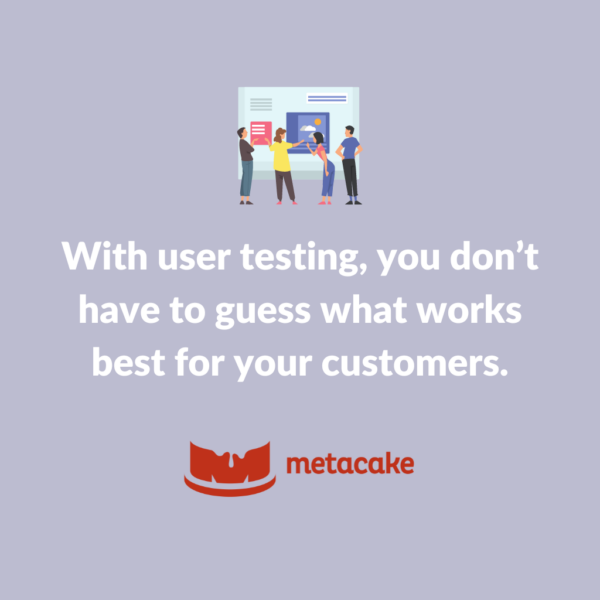Many businesses rely on best practices out of necessity when they’re first starting out… but best practices aren’t necessarily the best methods for your brand.
There are so many resources out there just waiting to tell you how to build the “best ecommerce website.” And, of course, genuine best practices can give you a good starting point.
But best practices don’t know you, and they don’t know your target customers.
Enter: user experience testing.
With online purchasing now ubiquitous, users (aka potential customers) have higher expectations and lower friction tolerance than ever before. They need quick load times, easy navigation, attractive visuals, and more.
And that’s why user testing is an important part of the design process. The real best practice is to let your customers show you what works for them.

User Testing vs. Best Practices: The Good and the Bad
Let’s start by looking at both sides of the “best practices” approach to illustrate why user testing is such an important part of the design process.
The Good
A lot can be said for best practices and industry standards, so we aren’t suggesting you toss them aside altogether. Many best practices got to be best practices because the general populace subconsciously agreed that this was how they’d use the internet.
In ecommerce stores, for example, the cart icon almost always lives at the top right of navigation. Sure, you could try a floating cart or one that sticks to the bottom of the window, but we recommend following this standard to begin. It’s what customers expect; it’s how they’re used to shopping. They expend zero extra mental energy to locate that cart icon, making them much more likely to click through and buy.
The Bad
Your business isn’t like every other business out there. Your product, your target customer, and your brand are unique. So, while one set of recommendations on product images, button size, product page layout, or upsell offers may work for other businesses, they won’t necessarily work for yours.
This is where user testing becomes a crucial part of the design process. By trying out various implementations of these elements, you let your customers tell you what they prefer through their actions.
Why User Testing Is an Important Part of the Design Process
User testing harbors enormous potential for ecommerce brands. If you commit to a full testing schedule, you’ll gradually develop a complete picture of what your customers think and how they interact with your site.
Want to increase purchases? Unclear about two conflicting “best practices” you saw online?
With user testing, you don’t have to guess what works best for your customers. Instead, you have a data-based roadmap telling you exactly which changes improve conversions and by how much.

How to Implement User Testing
If you don’t have a background in A/B testing or running test campaigns, jumping into user testing might sound daunting. It doesn’t have to be.
Start With Low-Hanging Fruit
To begin, look at your analytics to identify areas with big opportunities for improvement: low conversion rates, drop-offs in your conversion funnel, or high bounce rates from certain traffic sources.
For example, social traffic, though important in the lifecycle of a sale, generally has a low conversion rate for first-time visitors. As such, it provides a great opportunity to experiment. Try customizing the experience for this segment, taking advantage of user testing to identify new, effective ways to increase their conversion rate.
Besides looking at your analytics, focus on high-traffic pages and major decision points. Below are some areas where we often begin:
- Homepage: This high-volume page frequently brings in cold traffic with little or no background on your brand. User testing is an important part of the design process for this page, helping ensure you’re displaying the most relevant information and direction for new visitors.
- Product Page: Here, visitors decide whether they’re interested in your product, so finding the most effective images, layout, and information is key.
- Cart: The cart is often where people decide whether they’ll make a purchase. This may be a good place for upsells or promotions, but you don’t want to distract too much from the actual checkout. User testing helps you hit the right balance for your customers.
- Checkout Flow: To get customers to the finish line, the checkout process must be as seamless as possible. From the user’s perspective, checkout is a cumbersome process, especially on mobile devices with tiny fields and varying functionalities for data input. Without question, it’s the area of highest friction for ecommerce stores.Though Apple Pay, PayPal, Shopify Payments, and others have made huge strides in simplifying the process, checkout is still a pain, and it benefits from user testing.
Take Advantage of User Testing Tools
To start user testing, you can choose from several great tools. Here are three we recommend:
Foster User Testing Skills
The most important skill — and the most difficult skill to master — is the ability (and willingness) to put yourself in your customer’s shoes. As business owners, managers, and marketers, we often think we know what will work best based on instinct and experience. But you are not your customer.
If you’re serious about increasing conversions, resist the temptation to design a website in your own image. Put your opinion and instincts aside. We’re not saying they’re necessarily wrong, but they’re not necessarily right, either. Only user testing can tell you for sure.
Other necessary skills include:
- Ability to read analytics data
- UX and design
- Web development
User Testing: In-House or Outsource?
Can you manage user testing yourself, or should you outsource to a third party? Only you can answer that.
Consider how much time ongoing user testing will take away from other business operations and whether your team has the bandwidth and skills to execute it well.
If not, an outside vendor can be a great solution. Often, an experienced user testing partner brings more than just test execution expertise to the table; they also offer insightful, experienced-backed ideas for even more effective outcomes.
